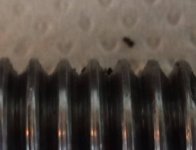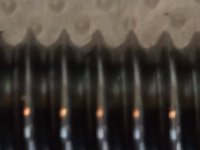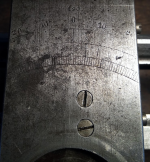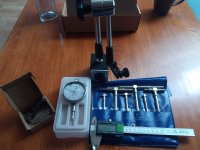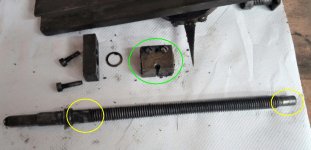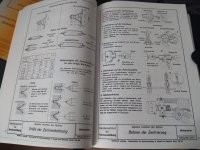JDM:
Your photos of the old book bring back memories of my teen-age years. I worked summers and part-time during my high school and college years in machine shops. The first shop I worked in was owned and run by German immigrants, who had come to the USA in 1923. They spoke mostly German in the shop. My grandmother spoke mostly Yiddish, and when my parents wanted to discuss something not for us kids' ears, they also spoke Yiddish. The result is I had some understanding of German, and that was what got me the job in that machine shop. As I worked with the machinists and the foreman, I picked up more German. At some point, the old foreman, having figured out I was able to handle calculations and read drawings, used to call me to his desk. It was something like: "Joe... bitte, kommst du und die rechnung machen". He would hand me a drawing for a job, and the handbook he used when he was an apprentice in Germany prior to 1923. The name of the book was "Tabellenbuch fur das Metallgewerbe". A lot of the calculations involved trigonometry, so I'd use the tables in the foreman's old book. It was in the days before pocket scientific calculators, so I had to do all the calculations 'long hand', with pencil and paper. The foreman or one of the toolmakers would check my mathematics. Sitting at the foreman's desk with his "Tabellenbuch", running calculations beat running a boring production job on a hand screw machine or Nichols production mill. I'd leaf thru the foreman's "Tabellenbuch" and pick up more technical German terms, which I remember to this day. I remember sitting at the foreman's desk with the paper, pencils, and his book and he'd bring me a quart of cold lager beer if it was during the afternoon. Your book is a good bit newer than the foreman's "Tabellenbuch", which was more of a general sort of handbook. Still, it does bring back the memories.
Just the other day, one of my friends called and asked if I'd come to another friend's automotive repair shop. The shop has a number of old machine tools. My friend had the arbor (shaft) from what we call a 'buzz saw', a circular saw used to cut firewood. He was adapting the old buzz saw to run off his tractor and the arbor needed some work, as did a new pulley. I set up the work in an 18" x 72" Monarch engine lathe built in February, 1942 and got to work. I skim cut the shaft journals as they were heavily corroded and pitted (the saw has babbitted bearings with plenty of shims for taking up clearance). I also turned the drive end of the shaft down to fit into a pulley, and bored the pulley hub to fit the shaft. It was a perfect day, doors to the shop open to let the sunlight and fresh air in, and people we knew kept passing thru the shop to visit. We joked: the lathe is 80 years old, and my friend with the buzz saw is one month older than the lathe. I am a kid, being a bit over 8 years younger than the lathe. I had not run that Monarch lathe in a good few years, but it is like playing a piano. I caught up with a number of people I had not seen in some time as I ran the old Monarch lathe, as my friend's shop is that kind of place. An old time country garage and machine shop. We've re-babbitted bearings there, repaired all sorts of things ranging from classic car parts to locomotive parts, antique engines, sawmill and woodworking machinery, and farm machinery. Skimming the journals on that saw arbor was no big deal as I know my friend has a bearing scraper and has scraped in plenty of babbitted bearings. I guess we are just old-timers who take this kind of thing as routine. My wife knew I was off to a good day with my bros, and knows I am in what I call a 'safe haven' when I am in a machine shop.
I am sure you will get a lot of enjoyment and quite a bit of education from your old lathe. As I like to say, anyone with the money (or nowadays, with a credit card) can buy new tools. Whether they can use them and turn out good work with those new tools is not guaranteed. When a person repairs, makes parts for, and makes some of their own tools, they are in a whole different class. It is not only a confidence builder, but teaches a person to think and plan and visualize as well as developing their manual skills and 'muscle memory'. I am sure that once you get your old lathe put right, you will wonder how you lived without it, and have many happy hours and good projects to be proud of resulting from it.


